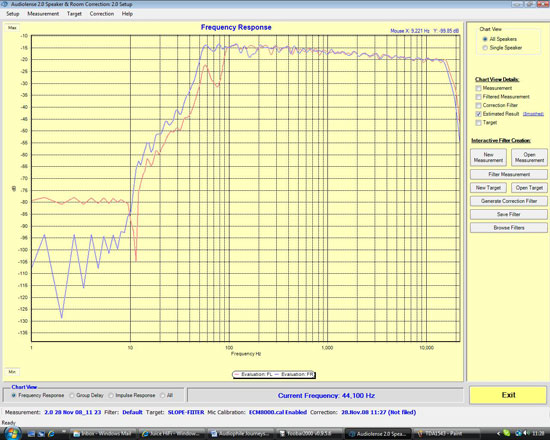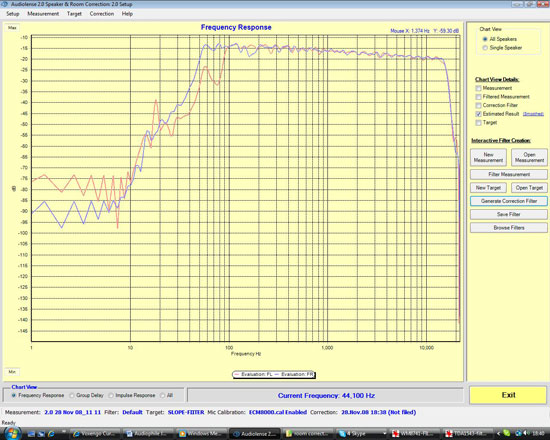Decisions, Decisions
Okay, let's apply room correction based upon the measurements taken earlier. I use a slight slope with 5dB of gain towards sub bass. I did try a flat line approach but found that the bass becomes too thin with the filter applied. Reading over the Audiolense guide, I noticed that there is a suggestion to slope things downward somewhat from low frequency to high frequency and I've found this to be my preference.
Let's have a quick look at the estimated room response for both DACs before we continue further. Unfortunately, Audiolense does not provide an option to record a frequency sweep after the correction has been applied. We've contacted Juice Hi-Fi about this and they've told us they're looking at providing this option in a future update. They did tell us that the estimated result is remarkably accurate based upon tests they've conducted themselves. If such an update is made available, we'll be sure to use the feature to present data in the future if the need arises.
Doede DAC |
Opus |
There is an unfortunate side effect at this point once the correction is applied to the TDA1543 DAC. The 20dB or so of attenuation applied by the filter means I have to turn the volume control to near maximum to get anywhere near the test volume I was using prior to applying the filters. A 6dB gain switch on the TVC does give me headroom of a couple of clicks, but it's far from optimal. To use this DAC with DRC, you'll either need to stack a number of TDA1543s in parallel or use some kind of gain stage on its output. Still, there's just about enough volume on tap for me to get an idea of its sonic signature in comparison to the earlier sound and in comparison to the WM8741.
With DRC engaged, instruments become far easier to pick out and subtle details are more noticeable at the listening position. The best word to describe the effects of DRC is balance. The other shocker is that the basic nature of both DACs remains the same. The TDA1543 midrange gains more edge definition especially on vocals (not that it needed them). The Opus soundstage gains pinpoint precision with lots of air. Complex passages of music are rendered without any perceivable congestion on both DACs.










114 Comments
View All Comments
goinginstyle - Wednesday, December 3, 2008 - link
I agree, while I might argue about some of the conclusions or have a different opinion, the author knows what the hell he is talking about. It is obvious from a lot of the comments that people stopped reading on page two and brought out the guns. It is fine to agree to disagree but some the comments here apparently came from five year olds and not adults. Sound quality is subjective, get over it. I appreciate a different opinion than my own and found the article to be thought provoking at times. Something an article should do when covering a hot topic like audio quality. Being an old hippie myself, I still love the tubes but digital has its place now. I vote that he does another article on this subject and lets see where AnandTech takes this in the future.strikeback03 - Tuesday, December 2, 2008 - link
How do you live in a rural area and not own a car?royboy66 - Tuesday, December 2, 2008 - link
hi I have been into audio and music for many years it is my hobby, computers are my business and hobby. I commend you guys for covering this topic -i will download the software you have used and give it a try.Wastral - Tuesday, December 2, 2008 - link
Well at least he talked about SOMETHING to do with the PC!DAC talk was good if really really wordy. Nothing like breaking points down into something someone can read.
Not one review of sound cards of sending analog output out from the computer and its actual quality... You know the main component needed in a PC... What a stooge.
Most People can't even hear over 16khz and the very rare person can hear around 20khz. I tested out at 18.3khz with a wave generator when I was 16. Now? Probably no more than 14khz at the age of 30. Not to mention the dB sensitivity of the ear over 16khz is next to nothing. On top of that, as I pointed out with a little thing called age your hearing decreases to 10khz by age 60 or so.
Of course If we really want this right, it has to be decoded at the amp, which won't happen, due to there being a million and 1 codecs around. Thus, we are stuck with analog.
Its all about your speakers and amp. That part of his article I won't complain about too loudly.
Just his BS about tube amplifiers. 10 years ago that was true. Now its only because old Hippies are retiring and tube amps were top of the line then and they have too much money and time on their hands to burn, with nostalgia hot in their blood.
Try recording something and then play it back with a tube amp or a Digital amp and compare the sound. No one uses Tube amps in studios. Why? Because it CHANGES THE MUSIC and is not as PURE as one can get with Digital amplifiers. They say they like it... wonderful, its not as true of a sound though, the HYPOCRITS!!!
Everything else was typical Audiophile BS ignorance. Hell, I have even installed an outlet for an "audiophile" pointed North-South for better "power" to his amp. No joke, he whipped out a compass.
Comments like, "I only use silver 24 guage wire." DUMB shit!! Go another guage larger in copper is a hell of a lot cheeper and gets better results.... IDIOT. Not to mention its your CONNECTORS THAT COUNT.
Rajinder Gill - Tuesday, December 2, 2008 - link
Where did I sue the word 'only' in that statement about wire?Seems you've done the typical thing and read what you want to read.
My entire cable setup costs less than $40, including the interconnects and mains cables. No north-south compass in my house either.
Connections are direct soldered where they can be and if it's practical enough. No expensive connectors used.
I'll aslo refrain from using the derogatory language you seem so comfortable with.
Rajinder Gill - Tuesday, December 2, 2008 - link
correction meant 'use'..Geraldo8022 - Tuesday, December 2, 2008 - link
Mr Gill is trying to do some of you a favor by cluing you in, but some of the denser posters come back with talk about receivers, headphones, soundcards, measurements, double blind testing, Class D, etc.
Someone once asked Satchmo what jazz was and his reply was, "if you gotta ask you don't get to know." I guess some of you here aren't gonna get to know. Just keep your head in the sand, or elsewhere.
I have been into HiFi for almost forty years and it is about things like sitting in the dark at one o'clock in the morning with Sarah Vaughn. If that doesn't make any sense to you, then you don't get to know.
Mr Gill, I thank you for this article. You keep on keepin' on.
Beefmeister - Tuesday, December 2, 2008 - link
Great choice on the Opus DAC; the Twisted Pear Audio guys do great work. I've built myself a Buffalo DAC.That being said, I would strongly suggest you look at replacing your Ballsie with IVY modules. IVY is capable of zeroing the DC offset from the DAC, thus allowing you to jumper the output coupling caps on the Opus. It also gets rid of the dual and quad OPAMPs of the Ballsie, which apparently don't measure as good as the single and dual variants.
draak13 - Monday, December 1, 2008 - link
Starting off with reading the article, I was getting quite pissed about how much this was going into the usual audiophile BS, where their 'prowess' of electronics goes so far as, "the resistor says 1000 ohms, but really, it TASTES like 992 ohms. There's such a huge difference." I was half expecting there to be talk of putting sandbags around the room to 'enhance the musical quality of the room setting.'Reading further, I found that this article was quite good, and was even moderately scientific as I have come to expect from Anandtech. The choice of the recording microphone was EXCELLENT; I looked up the spec sheet for that, and the response on that mic is absolutely incredible, and is a total steal for the price you pay. Kudos to anandtech for finding and using it. The very objective comparisons of two different dacs was quite excellent, as were the multiple recordings.
I absolutely loved your analysis of an addition of a subwoofer into the system to compensate for the range of the main speakers. I have always been curious about how well that would actually work. Lastly, I was blown away by your DRC analysis. That's an INCREDIBLE algorithm that you have there; I love it.
There are a few things that I could say about the choice of components, and the squabbling going on about what components "perform better", but there is an end-all test that you could do to prove what is and isn't BS. First, I can flat out GUARANTEE you that your microphone is as sensitive or more sensitive than the human ear AT LISTENING VOLUME. That is, anything that you can hear, that microphone should be able to hear as well. So, if you wanted to turn your subjective listening tests into objective listening tests, then play back those songs you were testing your setup with, but record those songs at listening position with your microphone using all of your different setups. Record them multiple times, as you have been doing in your tests. Next, using MATLAB or whatever other software, overlay the recorded waveforms and determine the differences between the two. If there truly is a difference between the different hardware setups that you were using, I guarantee that this will be sensitive enough to detect that difference, and will do so quantitatively.
DeepThought86 - Monday, December 1, 2008 - link
At the end of the day, is all this expensive tomfoolery just to listen to music? Why pay extra and turn your brain to jelly to boot?